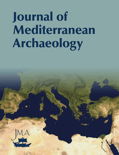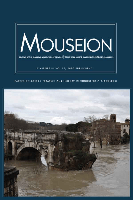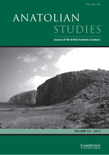
Journal of Mediterranean Archaeology
Scope & Guideline
Advancing Knowledge in Mediterranean Archaeology
Introduction
Aims and Scopes
- Interdisciplinary Approaches to Archaeology:
The journal encourages the use of various methodologies, including statistical analysis, GIS modeling, and bioarchaeological studies, to interpret archaeological data and understand past societies. - Cultural and Social Dynamics:
Research published in the journal frequently explores social structures, cultural practices, and the impact of historical events on Mediterranean societies, highlighting themes of conflict and cooperation. - Historical Contextualization:
Papers often involve a thorough examination of historical sources alongside archaeological findings, aiming to provide a comprehensive view of the Mediterranean's past. - Focus on Specific Regions and Periods:
The journal covers a wide range of geographical areas and historical periods, from the Bronze Age to the Hellenistic period, allowing for detailed regional studies. - Engagement with Contemporary Debates:
The journal serves as a platform for discussion and debate regarding archaeological methodologies and interpretations, fostering a critical dialogue among scholars.
Trending and Emerging
- Integration of Environmental Data:
Recent publications increasingly utilize environmental and ecological data to understand human interactions with landscapes, emphasizing sustainability and agricultural practices in ancient societies. - Interconnectedness of Cultures:
There is a growing emphasis on exploring the connections between different Mediterranean cultures, particularly through trade, migration, and shared practices, as evidenced by studies on Iron Age entanglements and settlement strategies. - Reevaluation of Historical Sources:
A trend towards reexamining historical texts and their implications for archaeological findings is evident, as researchers seek to create more nuanced interpretations of the past. - Social and Ritual Practices:
Emerging themes focus on the analysis of social practices, including funerary rituals and domestic spaces, revealing insights into the lived experiences of ancient peoples. - Technological Innovations in Archaeology:
The application of advanced technologies such as GIS and statistical modeling is becoming more prominent, allowing for innovative approaches to data analysis and site interpretation.
Declining or Waning
- Traditional Artifact Studies:
There appears to be a decreasing emphasis on purely descriptive studies of artifacts, as more researchers lean towards contextual analyses that integrate artifacts with social and environmental factors. - Narrow Geographic Focus:
Papers that concentrate solely on localized studies without broader implications or connections to the Mediterranean context are less frequently published, indicating a trend towards more integrative approaches. - Static Interpretations of Decline:
The exploration of decline narratives in archaeological contexts has waned, as scholars increasingly question and critique these established narratives in favor of more dynamic interpretations of societal changes.
Similar Journals

Mediterranean Archaeology & Archaeometry
Innovating Research in Archaeometry and HistoryMediterranean Archaeology & Archaeometry is a premier academic journal dedicated to advancing the fields of archaeology, anthropology, conservation, and history, published by UK Zhende Publishing Ltd. With its ISSN 1108-9628 and E-ISSN 2241-8121, this journal serves as a vital platform for scholars and practitioners to disseminate innovative research and findings related to the rich archaeological heritage of the Mediterranean region. It has gained remarkable recognition, achieving a Q2 ranking in anthropology and archaeology, and a Q1 classification in several categories including arts and humanities, conservation, and history as of 2023. Its impressive Scopus rankings underscore its impact, with a significant position in history (59/1760) and conservation (11/103) disciplines. Spanning years from 2008 to 2022, the journal invites open access contributions to foster collaboration and interdisciplinary dialogue among researchers, students, and professionals alike, making it an indispensable resource for those engaged in the exploration and preservation of historical narratives within the Mediterranean context.

Mouseion-Journal of the Classical Association of Canada
Exploring the legacies of ancient cultures.Mouseion - Journal of the Classical Association of Canada, published by University of Toronto Press Inc, stands as a vital academic resource in the fields of Classics and Archaeology. With a focus on promoting scholarly discourse, this journal provides a platform for original research, critical reviews, and interdisciplinary studies that engage with ancient cultures and their legacies. Since its convergence in 2019, Mouseion has quickly established itself within the academic community, achieving a commendable Q1 ranking in Classics and Q2 in both Archaeology categories in 2023, showcasing its commitment to excellence. While not an open-access journal, it is positioned among the top 29% of classics journals, reflecting its impact and the quality of publications. Nestled within Canada, this journal addresses a global audience of researchers, professionals, and students dedicated to the exploration of the classical world, and it endeavors to contribute significantly to the scholarly understanding of cultural heritage.

ARCHAEOLOGY
Pioneering Archaeological Research for Future GenerationsARCHAEOLOGY is a distinguished peer-reviewed journal published by the Archaeological Institute of America, focusing on the multifaceted aspects of archaeological research and its relevance to contemporary society. Established in 1966, this journal serves as a critical platform for scholarly discourse in the field, showcasing innovative findings, theoretical advancements, and methodological discussions related to archaeology. While it maintains a Q4 ranking within the disciplines of archaeology and arts and humanities, its contributions remain valuable for those engaging in archaeological studies or seeking to understand historical and cultural narratives. The journal is accessible in print, with an ISSN of 0003-8113 and an E-ISSN of 1943-5746, ensuring that a wide audience can benefit from its insights. Although currently not classified as Open Access, the meticulous peer-review process ensures a high standard of academic rigor, making it an essential source for researchers, professionals, and students alike who are dedicated to exploring the past through archaeological lenses.

Journal of Ancient History and Archaeology
Exploring the Depths of Ancient CivilizationsJournal of Ancient History and Archaeology is a premier, open-access academic journal published by MEGA PUBLISHING HOUSE since 2014, dedicated to exploring the rich tapestry of ancient civilizations and archaeological discoveries. With ISSN 2360-266X, this journal has made significant strides in the field, achieving elevated rankings across multiple categories, including Q1 in Classics and Q2 in History as of 2023. Positioned in Romania, the journal serves an international audience of researchers, professionals, and students who seek to disseminate and access influential scholarship in ancient history and archaeology. As a prominent resource within the Scopus rankings, it reflects a robust commitment to advancing knowledge through quality research, making it a vital platform for the sharing and discussion of innovative ideas and methodologies. The journal covers a wide array of topics related to ancient societies, enhancing our understanding of their cultural, historical, and archaeological significance.

Studia Historica-Historia Antigua
Unlocking the Secrets of History's PastStudia Historica-Historia Antigua is a distinguished Open Access journal published by EDICIONES UNIV SALAMANCA, dedicated to the advancement of research in the field of ancient history. With a solid foundation since its inception in 1983, this journal has maintained its commitment to accessibility and knowledge dissemination, reaching a wider audience in Spain and beyond. ISSN: 0213-2052 and E-ISSN: 2530-4100 enable seamless engagement with its scholarly content. Ranked in the second quartile (Q2) in the History category in 2023 and occupying the 903rd position out of 1,760 in the Scopus ranking for Arts and Humanities, the journal underscores its relevant position in the academic landscape. Its converged years from 2017 to 2024 highlight ongoing scholarly dialogue while facilitating the exploration of diverse perspectives in ancient history. This journal serves as a vital resource for researchers, professionals, and students aiming to deepen their understanding of historical narratives and methodologies. Located in Salamanca, Spain, Studia Historica-Historia Antigua is not only a platform for rigorous academic discourse but also a contributor to the collective pursuit of historical insights in the evolving field of history.

Archeologicke Rozhledy
Advancing archaeological scholarship for a global audience.Archeologicke Rozhledy, published by the Academy of Sciences of the Czech Republic, Institute of Archaeology, is a pivotal open-access journal dedicated to advancing the field of archaeology. Since transitioning to open access in 2019, it has made significant strides in disseminating high-quality research, serving as a vital resource for researchers, professionals, and students alike. With an ISSN of 0323-1267, the journal has gained recognition for its contributions in the domains of arts and humanities, particularly archaeology, as evidenced by its 2023 Q2 ranking in both categories. Operating out of the historical city of Prague, the journal encompasses a broad scope of archaeological scholarship, reflecting a commitment to interdisciplinary approaches and fostering dialogue within the global archaeological community. With its notable Scopus rankings—#115/413 in Arts and Humanities and #113/354 in Social Sciences—Archeologicke Rozhledy stands as a crucial outlet for innovative research and scholarly exchange.

JOURNAL OF MEDITERRANEAN STUDIES
Unveiling the Complexities of Mediterranean LifeJOURNAL OF MEDITERRANEAN STUDIES, based at the Mediterranean Institute, University of Malta, serves as a vital platform for scholarly discourse within the fields of anthropology, cultural studies, and the broader arts and humanities. Established with the aim of exploring the rich tapestry of Mediterranean cultures and societies, this journal offers an invaluable resource for researchers, professionals, and students alike. Although it operates under a traditional subscription model, the journal ensures comprehensive accessibility to its diverse range of articles, enhancing the visibility of Mediterranean studies. With an ISSN of 1016-3476 and E-ISSN 2523-9465, it garners attention across various academic ranks, notably a Q4 classification in multiple categories as per the 2023 evaluation, indicating its unique contributions to these disciplines despite its emerging status. As researchers delve into its volumes, they are invited to engage with a wealth of interdisciplinary insights that illuminate the Mediterranean’s complex social and cultural dynamics.

International Journal of Historical Archaeology
Illuminating Discoveries: Insights into Our Shared Historical JourneyInternational Journal of Historical Archaeology, published by SPRINGER, stands at the forefront of archaeological scholarship, focusing on the intricate relationship between historical events and archaeological findings. With an impressive impact factor underscored by its ranking in the Q1 quartiles across various categories, including Archeology and History, this journal serves as a premier platform for researchers, professionals, and students alike to disseminate groundbreaking findings and theoretical advancements in the field. Although it is not an Open Access publication, the journal provides valuable insights through its rigorous peer-review process, enhancing the quality of contributions. Covering a breadth of topics from 1997 to 2024, it is vital for advancing knowledge in historical archaeology and offers an essential resource for those invested in understanding our shared past through the lens of material culture. The journal's commitment to fostering interdisciplinary discussions enriches the scholarly community and supports the evolution of methodologies and perspectives within the domain.

Anatolian Studies
Advancing Knowledge in Archaeology and Cultural StudiesAnatolian Studies, published by Cambridge University Press, stands as a premier forum for research in the fields of archaeology, cultural studies, and history. Established in 1951, this esteemed journal has consistently contributed to the academic discourse surrounding the rich and multifaceted history of Anatolia, earning its place in the Q1 category across multiple disciplines. With a notable impact factor reflected in its Scopus rankings, it ranks among the top journals in its fields: 78th in History, 155th in Cultural Studies, and 55th in Archaeology, showcasing its significant influence and recognition. This journal serves as an invaluable resource for researchers and scholars seeking to delve into the intricacies of Anatolian heritage, providing a platform for innovative research and critical discussion within the academic community. While it currently does not offer open access, Anatolian Studies continues to enrich scholarly resources and advance knowledge within its key areas of focus.

Egyptian Journal of Archaeological and Restoration Studies
Connecting Past and Future through Scholarly Research.Welcome to the Egyptian Journal of Archaeological and Restoration Studies, a vital resource for scholars and practitioners in the field of archaeology and restoration. Published by the renowned SOHAG UNIV PUBLICATION CENTER-SUPC, this journal aims to disseminate cutting-edge research that illuminates the rich archaeological heritage of Egypt and beyond. With ISSN 2090-4932 and E-ISSN 2090-4940, this journal showcases innovative methodologies and interdisciplinary approaches, significantly contributing to our understanding of cultural heritage preservation. The journal's growing influence is reflected in its Q3 ranking in multiple categories, including Archaeology, Conservation, and Cultural Studies as of 2023, alongside its noteworthy placement within the Social Sciences. Open access options provide wider accessibility to essential studies, making it an indispensable tool for researchers, professionals, and students alike. Join us in exploring the past and shaping the future of archaeological scholarship.